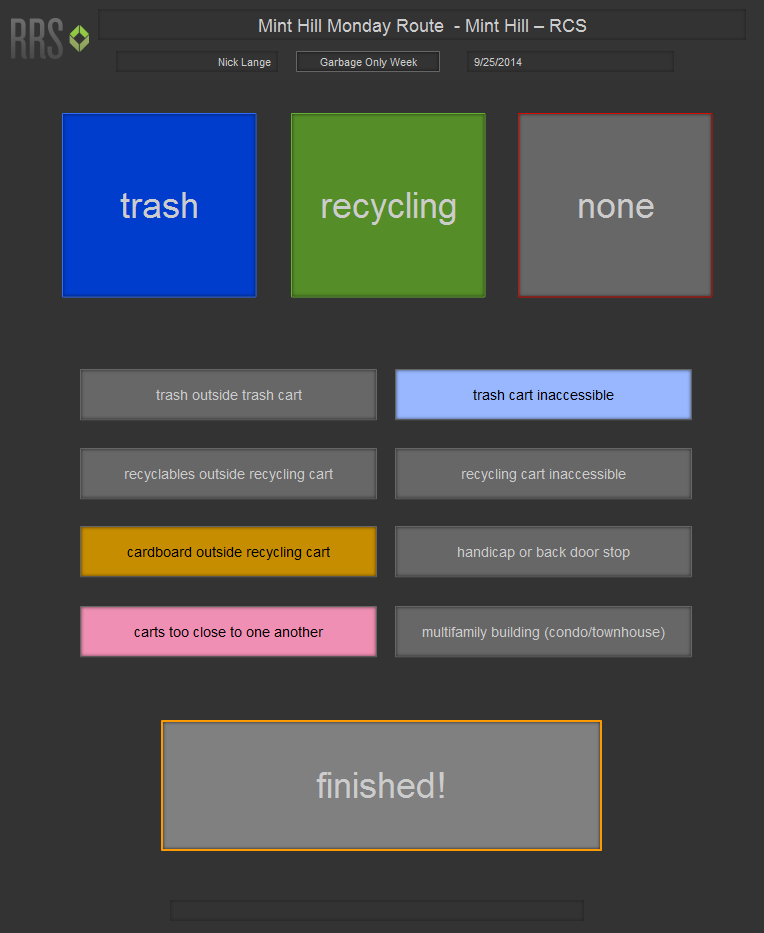Cool thing by RRS: Mobile App for Set-Out Rate Study
In-person data gathering. This doesn’t stir up images of “cool”. It more likely stirs up images of clipboards, pencils and transcribing data into a spreadsheet.
Heading into a recent project with Mecklenburg County, North Carolina, our project team was thinking about various ways to gather garbage and recycling set-out rate data. In other words, counting how many houses on a given trash and recycling route set out their containers for service.
Use clickers while driving? Use paper to mark down set-outs and transcribe data into a spreadsheet at the end of the day? Staff the car with two people — one driving, another on a laptop? What about verification? What about knowing who is following what route? What about understanding when and where you are on a route? How can we minimize errors using temporary field staff? What should we do to manage special circumstances and notes in the field? The questions kept coming. How could we do all this safely? While driving. Slowly. Behind a garbage truck.
This is where the cool factor comes in. Cross team collaboration – data heads, operations, project manager – understanding the tools available and how to use them effectively.
Leading into the project we held a team meeting where Nick Lange, a consultant on our tech team, exclaimed, “Oh yeah, I can make a simple tablet interface for that. We can customize it and field staff can touch buttons on the tablet screen to record data for each set-out.” After a few clarifying questions and decisions about how we’d be able to track data using this method, any talk of clickers and clipboards was forgotten. The conversation turned to logistics around getting tablets into the field, training field staff, and a backup plan for technical difficulties that may pop-up during our month long field study.
 Now, most things that are cool are not cool right out of the box. The idea can be cool, and the problem solving can be cool, but the “thing” cannot really be cool unless it works and delivers in ways that were unexpected. Looking back, our mobile app tool was cool from the start. Here are some examples of the performance we got and were not planning for – the things that made us smile and say “cool!”
Now, most things that are cool are not cool right out of the box. The idea can be cool, and the problem solving can be cool, but the “thing” cannot really be cool unless it works and delivers in ways that were unexpected. Looking back, our mobile app tool was cool from the start. Here are some examples of the performance we got and were not planning for – the things that made us smile and say “cool!”
- Data tracking in real time. As field staff were recording setouts, the database was getting populated in real time. We could see what time it was, what route number they were following, and where they were located. Super helpful in managing temporary field staff and making sure everyone is working as planned.
- Updates to the interface. If our app design was not working or applicable to the needs of the project, we could make changes to the touch screen interface on the fly, including layout of buttons and the selection of pre-programmed field notes. This would change in real time as staff were using the app in the field.
- Maps. We knew we’d have GPS capabilities, but the mapping and layers we could create based on the longitude and latitude “ping” we’d get from each data point went beyond expectations. We were able to identify the route coverage, compare to house counts, and verify a correct level of sampling for each community.
I’ll be the first to say that gathering set-out rate data is relatively simple. The easiest method is for route drivers to have a clicker and to click for each customer that is picked up. At the end of the day this gives you a number, which can assist with route efficiency and paint a rough picture of resident behavior. But with the data we collected using the mobile app – applying the same amount of physical effort that a clicker would take – provided another level of data, including statistically valid sampling, electronically stored information, mapping, tracking, and most importantly client satisfaction. Now that’s pretty cool.
What other uses could you see for mobile apps in the waste/recycling world? Let us know in the comments section below.
Learn more about the RRS RouteEagle set-out rate study.
